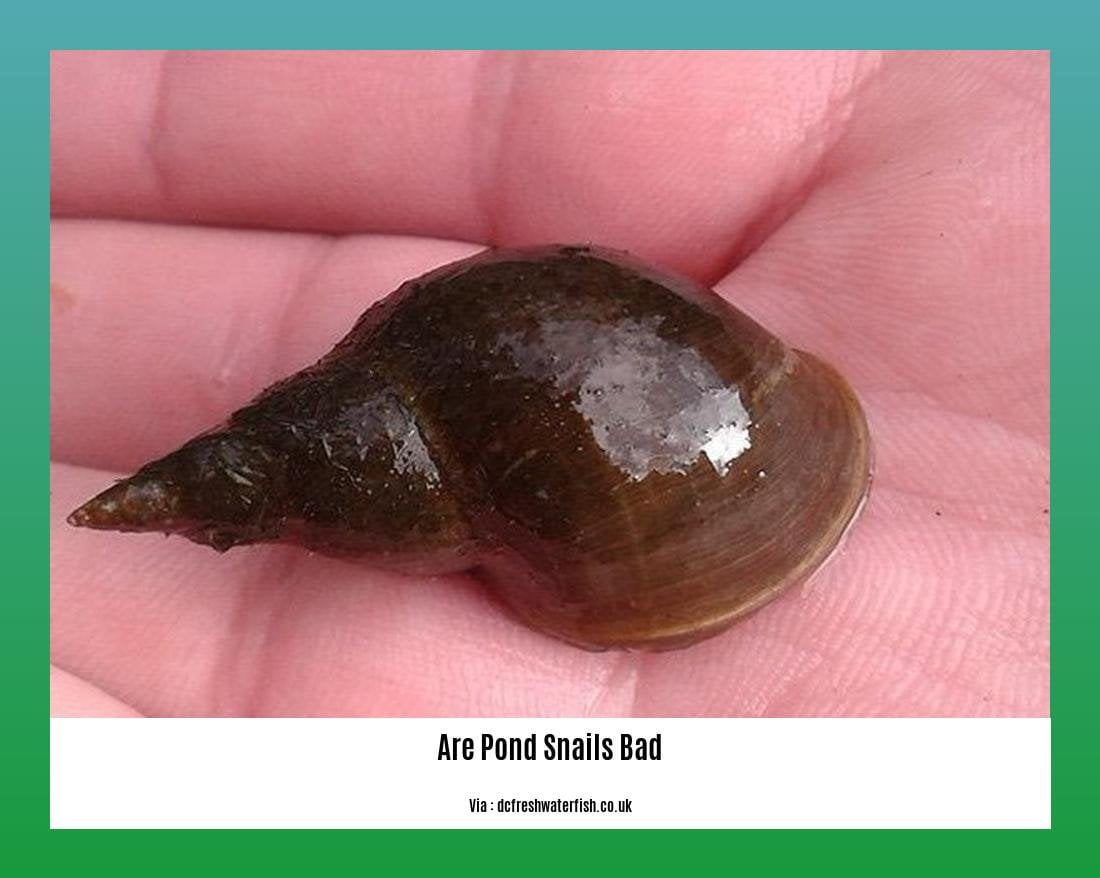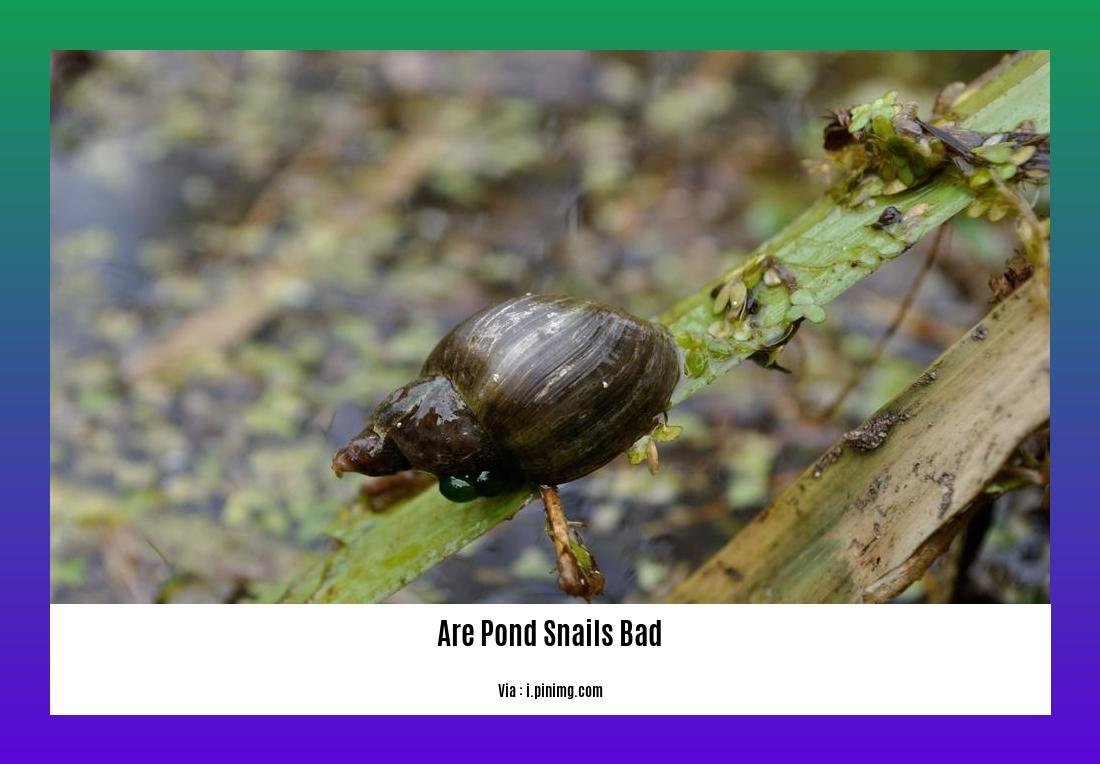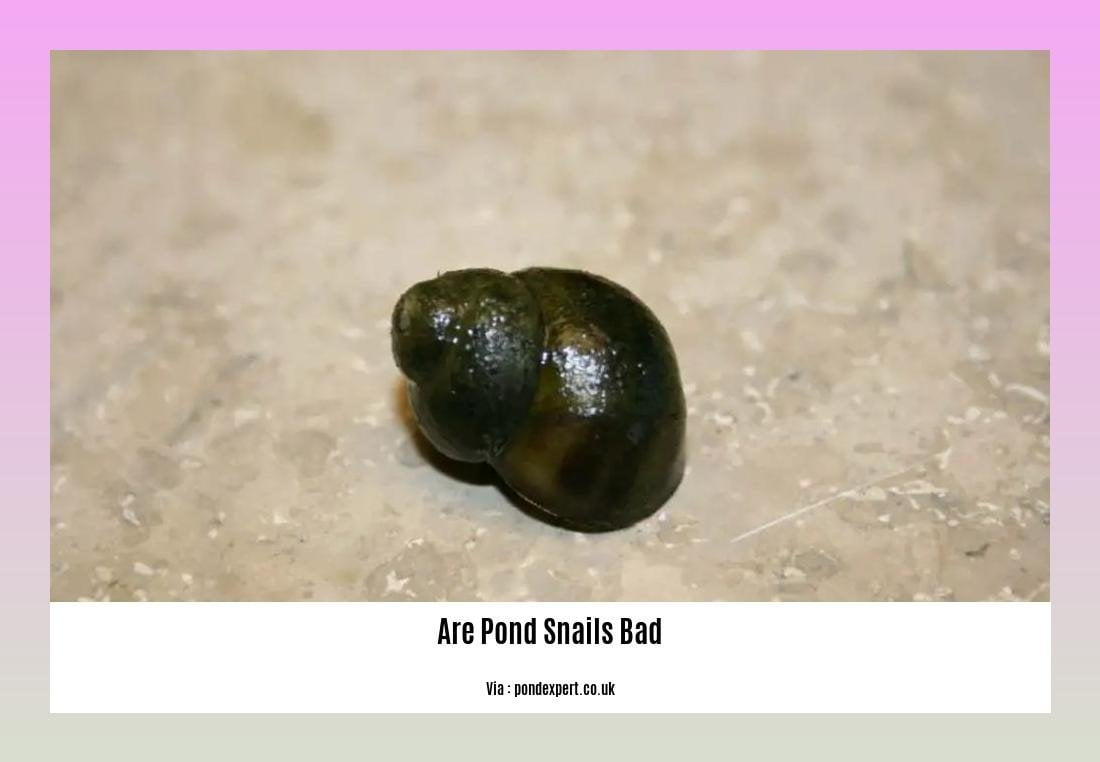Are Pond Snails Bad? Investigating the Ecological Significance and Management Strategies
As we delve into the world of freshwater ecosystems, one species often finds itself at the center of debate – pond snails. These small, seemingly unassuming creatures have earned a reputation as a nuisance, with many labeling them as “bad” for their impact on ponds. However, as an experienced freshwater biologist specializing in aquatic ecosystem management, I am here to shed light on the ecological significance of pond snails and provide valuable insights into their management strategies. Through this article, we will challenge preconceived notions and explore the positive aspects that these often-misunderstood snails bring to their habitats, while also addressing potential concerns and offering practical techniques for optimal pond health. So, are pond snails really bad? Let’s find out.
Key Takeaways:
- Having excessive snails in a pond can lead to pond sludge, decreased water quality, reduced oxygen levels, and the hosting of parasites.
- Snails can eat healthy algae and breed rapidly, leading to overpopulation and increased waste.
- Some snails can help control an overabundance of algae in the pond by eating healthy algae.
- To reduce snail numbers, tips on how to remove snails from the pond are provided.
- Pond snails have a varied diet, but generally eat algae and leafy vegetation.
- Snails in a pond can live for about a year and grow to be about 0.25 to 0.5 inches in size.
- An excessive snail population in a pond can cause waste and sludge formation.
- It is important to manage snail populations to maintain a healthy pond environment.
Are Pond Snails Bad?

Pond snails often get a bad reputation, with some people considering them a nuisance that can harm the health of aquatic ecosystems. However, it’s essential to take a closer look and explore the ecological significance of pond snails before passing judgment. In this article, we will dive into the world of pond snails, investigating their role within aquatic systems and providing practical management strategies for optimal pond health.
The Benefits of Pond Snails
Contrary to popular belief, pond snails actually provide several benefits to their habitats. One of their primary roles is algae control. Many species of pond snails feed on algae, helping to balance its growth and prevent an overabundance. In this way, they act as natural algae cleaners, maintaining a healthy balance within the pond ecosystem.
Additionally, pond snails play a vital role in nutrient cycling. As they consume organic matter, such as decaying plants and detritus, they break it down into smaller particles. This breakdown process releases essential nutrients back into the water, making them available for other organisms like plants and bacteria. In this sense, pond snails can be seen as nature’s recyclers, contributing to the overall health and vitality of the pond.
Potential Concerns and Management Strategies
While pond snails offer numerous benefits, there can be issues when their populations become excessive. Excessive snails can lead to the accumulation of waste and sludge, which can negatively impact water quality and oxygen levels. Moreover, certain species of snails can host parasites, posing potential threats to other organisms in the pond.
To maintain a healthy balance, it’s important to manage snail populations. Here are some practical strategies to consider:
-
Mechanical removal: When snail populations become excessive, manual removal can be an effective control measure. This can be done by handpicking snails or by using traps specifically designed to catch them. Regularly monitoring and removing snails can prevent overpopulation and minimize potential negative effects.
-
Biological controls: Introducing natural predators can help regulate snail populations. For example, certain fish species, such as koi or goldfish, feed on snails and can help keep their numbers in check. However, it’s crucial to select appropriate predator species that won’t harm other desired organisms in the pond.
-
Maintaining balance: Creating a well-balanced ecosystem is key to preventing snail overpopulation. This can be achieved by promoting a diverse range of plants, creating hiding places for fish and other predators, and maintaining proper water quality parameters. By fostering a healthy ecosystem, the natural checks and balances of the pond can help control snail populations.
In Conclusion
In conclusion, the question “Are pond snails bad?” does not have a straightforward answer. While an excessive number of snails in a pond can lead to various negative effects, such as diminished water quality and the hosting of parasites, pond snails also serve important roles within aquatic ecosystems. Their ability to control algae and contribute to nutrient cycling is crucial for maintaining the overall health and balance of the pond. By implementing proper management strategies and maintaining a well-balanced ecosystem, the potential benefits that pond snails bring can be maximized while minimizing any potential negative impacts. So, rather than categorizing pond snails as “bad,” let’s strive to understand and appreciate their ecological significance.
Are you interested in learning about aquatic habitat information? Click here to explore more and dive into the fascinating world of underwater ecosystems.
If you’re wondering whether goldfish are good for ponds, find out the answer here and discover the benefits of having these beautiful fish in your pond.
Are lakes safe to swim in? Get all the facts and reassurance you need by clicking here to learn about the safety of swimming in natural bodies of water.
Examining the Positive Aspects of Pond Snails in Their Habitats
Pond snails: are they a valuable addition to your aquatic ecosystem or a nuisance? This article aims to shed light on the often misunderstood perception of pond snails by exploring their positive aspects within their habitats. With their unique characteristics and ecological significance, pond snails play a crucial role in maintaining the health and balance of pond ecosystems.
The Benefits of Pond Snails
1. Maintenance of Algae Growth: Pond snails act as natural algae cleaners, helping to control and balance algae growth in ponds. They consume excess algae and prevent it from overpopulating the ecosystem.
2. Natural Pond Janitors: Snails are nature’s janitors for ponds. They feed off sludges and other organic waste, contributing to the cleanliness and overall health of the pond.
3. Decorative Animals: Some people choose to introduce snails to their ponds for their ornamental value. With their unique shapes and patterns, snails can add beauty and visual interest to the aquatic environment.
4. Filtration Aid: Pond snails play a crucial role in the filtration of pond water. They transform sediments into nitrogen, which is beneficial for the overall water quality and ecosystem of the pond.
5. Indicator of Water Quality: The behavior of pond snails can serve as a warning sign for poor water quality. If snails exhibit unusual behavior or their numbers decline significantly, it may indicate an issue with the pond’s water quality.
Practical Management Strategies
While pond snails offer numerous benefits, it’s essential to strike a balance within your pond ecosystem. Here are some practical strategies for managing snail populations:
-
Mechanical Removal: If the snail population becomes excessive, manual removal can be an effective solution. Handpicking snails or using traps designed for snails can help control their numbers.
-
Introducing Natural Predators: Introducing certain fish species that feed on snails can help control their population. These natural predators can help maintain a healthy snail population in the pond.
-
Maintaining a Well-Balanced Ecosystem: A well-balanced ecosystem is key to managing snail populations. Promote a diverse range of plants, as they provide hiding places for predators. Additionally, maintaining proper water quality parameters, such as temperature, pH, and water hardness, can help keep the pond in optimal condition.
By implementing these management strategies and maintaining a well-balanced ecosystem, you can maximize the benefits that pond snails bring while minimizing any potential negative impacts. With careful observation and appropriate management, pond snails can be valuable contributors to a thriving and healthy pond environment.
Key Takeaways:

- Pond snails provide multiple benefits to their habitats, including algae control and nutrient cycling.
- They act as natural algae cleaners, helping to balance algae growth.
- Pond snails break down organic matter and release essential nutrients back into the water.
- Excessive snail populations can lead to waste accumulation, negatively impacting water quality and oxygen levels.
- Certain species of snails can host parasites, posing potential threats to other organisms.
- Practical strategies for managing snail populations include mechanical removal, introducing natural predators, and maintaining a well-balanced ecosystem.
- Mechanical removal can be done through handpicking or using traps designed for snails.
- Introducing natural predators, like certain fish species, can help control snail numbers.
- Maintaining a well-balanced ecosystem involves promoting a diverse range of plants, creating hiding places for predators, and maintaining proper water quality parameters.
- By implementing proper management strategies and maintaining a well-balanced ecosystem, the benefits that pond snails bring can be maximized while minimizing any potential negative impacts.
References:
[^1^]: Are Snails Good for Ponds? (4 Tips to Get Rid of Them). Retrieved from mybackyardlife.com
[^2^]: A Complete Guide to Pond Snails | The Goldfish Tank. Retrieved from thegoldfishtank.com
Addressing Concerns Regarding Pond Snails and Their Management Strategies
Pond snails, also known as Lymnaeidae, are often a topic of controversy when it comes to their presence in aquatic systems. There are concerns about their impact on the ecosystem and how to manage their populations effectively. In this article, we will dive deep into these concerns and provide practical strategies for addressing them.
The Role of Pond Snails in Aquatic Systems
Before delving into the concerns, it is essential to understand the ecological significance of pond snails. These gastropods play various roles within their habitats. They act as natural algae cleaners, helping to balance algae growth in the pond. By consuming excess algae, pond snails prevent it from overpopulating and disrupting the ecosystem[^1^].
Moreover, pond snails contribute to the breakdown of organic matter, like sludges, and release essential nutrients back into the water. This nutrient cycling process helps maintain a healthy pond environment[^1^]. They also serve as indicators of water quality, as their behavior can signal potential issues in the pond’s ecosystem[^1^].
The Concerns: Are Pond Snails Bad for Your Pond?
Now let’s address the concerns surrounding pond snails. One of the primary concerns is the potential overpopulation of snails, which could lead to waste accumulation and negatively impact water quality and oxygen levels. While pond snails provide vital ecological functions when present in appropriate numbers, excessive populations can indeed become problematic[^1^].
Another concern is the possibility that certain species of snails may host parasites, which can pose threats to other organisms within the ecosystem. It is essential to be aware of this potential risk and take necessary precautions to maintain the balance of the pond[^1^].
Practical Management Strategies
To address these concerns and maintain a healthy and balanced pond ecosystem, here are some practical management strategies to consider:
-
Mechanical Removal: If you notice an excessive snail population in your pond, manual removal can be an effective strategy. This can be done by handpicking the snails or using traps designed specifically for snail removal[^1^].
-
Introducing Natural Predators: Another way to control snail populations is by introducing natural predators into the pond. Certain fish species, such as koi, can help keep snail numbers in check by preying on them[^1^].
-
Maintaining a Well-Balanced Ecosystem: A key strategy is to create a well-balanced ecosystem within your pond. This involves promoting a diverse range of plants, which can provide hiding places for predatory organisms that naturally control snail populations. Additionally, maintaining proper water quality parameters, such as temperature, pH, and water hardness, can help create an environment less favorable for snail overpopulation[^2^].
By implementing these management strategies, you can maximize the benefits that pond snails bring while minimizing any potential negative impacts.
Key Takeaways:
- Pond snails provide several benefits to their habitats, including algae control and nutrient cycling.
- Excessive snail populations can lead to waste accumulation, negatively impacting water quality and oxygen levels.
- Certain species of snails can host parasites, posing potential threats to other organisms.
- Practical strategies for managing snail populations include mechanical removal, introducing natural predators, and maintaining a well-balanced ecosystem.
- By implementing proper management strategies and maintaining a well-balanced ecosystem, the benefits that pond snails bring can be maximized while minimizing any potential negative impacts.
References:
- Pond Snails: Good or Bad for Your Pond? (Pros & Cons of Snails). Retrieved from Pond Academy
- Are Snails Good or Bad for Garden Ponds? (Pond Snail Facts). Retrieved from Pond Informer
Conclusion: The overall role and significance of pond snails in aquatic systems
Pond snails, such as the great pond snail (Lymnaea stagnalis), play a vital role in maintaining the quality of water and benefiting the ecosystem. Their impact goes beyond being mere inhabitants of freshwater habitats. These fascinating creatures have the ability to recycle nutrients, feed on dead organisms, and regulate microbial expansion, making them essential components of the ecosystem.
By recycling nutrients, pond snails prevent the buildup of excessive nutrients in the water, which can lead to imbalances and potential harm to other aquatic organisms. They also act as nature’s cleaners by consuming decaying matter, keeping the water clean and free from contaminants. Furthermore, pond snails help regulate microbial expansion, creating a healthy and stable environment for other organisms.
Additionally, studies have shown that pond snails, including Lymnaea stagnalis, have been used as model organisms in various biological research. Their versatility allows them to be utilized in genetics, embryology, drug inhibition experiments, and even gene editing studies. By understanding the biological processes in snails, we gain valuable insights into similar processes in other organisms.
In summary, pond snails, particularly the great pond snail (Lymnaea stagnalis), are of significant importance in freshwater ecosystems. Their ability to balance water quality, recycle nutrients, regulate microbial expansion, and serve as model organisms in biological studies make them essential components of the natural world. Appreciating the role and significance of pond snails is crucial for understanding and conserving aquatic environments.
Key Takeaways:
- Pond snails, such as the great pond snail, play a crucial role in maintaining the quality of water and benefiting the ecosystem.
- They recycle nutrients, feed on dead organisms, and regulate microbial expansion.
- Pond snails prevent nutrient buildup, keeping the ecosystem in balance.
- They act as nature’s cleaners by consuming decaying matter, ensuring clean water.
- Pond snails, including Lymnaea stagnalis, have been used as model organisms in biological studies.
- Understanding the roles and significance of pond snails is essential for conserving aquatic environments.
Sources:
– Learn About Nature. “Pond Snails – Complete Guide to Essential Components of Aquatic.” Link
– EvoDevo. “The pond snail Lymnaea stagnalis.” Link
FAQ
Q1: What are the potential negative impacts of having pond snails in a pond?
A1: Having an excessive number of snails in a pond can lead to various negative effects such as pond sludge, decreased water quality, reduced oxygen levels, and the hosting of parasites.
Q2: Can pond snails help control algae in a pond?
A2: Yes, snails can help maintain algae growth in ponds by consuming the excess algae and preventing it from overpopulating the ecosystem.
Q3: How do pond snails contribute to the cleanliness of a pond?
A3: Pond snails act as natural janitors for ponds by feeding off sludges and other organic waste, thus helping to keep the pond clean and healthy.
Q4: Are pond snails beneficial for the overall water quality of a pond?
A4: Yes, pond snails play a role in pond filtration by turning sediments into nitrogen, which can be beneficial for the overall water quality and ecosystem of the pond.
Q5: What are some management strategies for controlling pond snail populations?
A5: If you want to control or get rid of snails in a pond, there are several methods you can try, such as manual removal, using snail traps, adding snail predators, or adjusting the pond’s water conditions.
- Unveiling the Enigma: Mansoureh Khojasteh Bagherzadeh’s Public Appearances & Private Life in Iran - July 18, 2025
- Unveiling the Mystery: Mansoureh Khojasteh Bagherzadeh’s Husband: A Rare Glimpse into a Private Life - July 18, 2025
- Unveiling Masoud Khamenei’s Mother: Power, Influence, and Iran’s Future - July 18, 2025
















